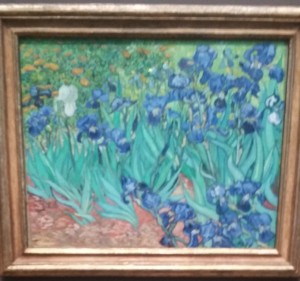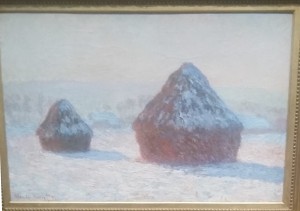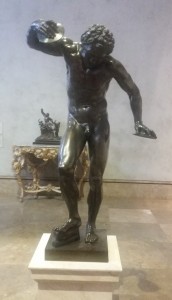A DAY AT THE GETTY MUSEUM
A DAY AT THE GETTY MUSEUM
By Charles N. Stevens
Photos by Dolores Seidman
Our bus left from the Langley Senior Center in the morning. When we became immersed in all the heavy traffic between Monterey Park and the Getty Museum, we were glad we were on a bus. It was so much better leaving the driving to a young bus driver than contending with it ourselves
Once our bus was safely parked in the underground parking lot at the Getty Museum, our group boarded large elevators that would take us up another floor where the trams left. Crowds of people, especially large groups of elementary school students, waited for the trams that would take us up the hill to the museum. The tram ride was very interesting as it rose and curved through the natural vegetation of the hills giving us a spectacular view of the 405 Freeway down below. Arriving at the museum was like entering the grounds of a white palace. We surmounted a long series of stairs that lead us to a large atrium where we received maps and other information that would help us decide what part of the museum we would like to see.
Dolores and I headed for the galleries of European art, especially the impressionist painters. On our way, we laughed at the many groups of elementary students, each wearing a certain colored shirt to help their teachers to keep track of them. We also glanced out at a rather hazy view of the city. But we’ll concentrate more on that later.
We were soon standing before one of our favorite paintings, Irises by Vincent van Gogh, painted in 1889, a year before his death. Deep blue irises bloomed among the pale green, sword-like leaves. Strangely, one of the iris blooms was white. Does that represent himself among other people, his difference? We gazed at the beauty of the painting for a long time. Growing tired, I sat on a bench and watched others admiring the paintings. I heard foreign voices among the English speakers and listened to the squeak of shoes on the hardwood floor. A baby cried from its stroller.
One of the Getty’s advantages was the magnificent view possible from its lofty perch on a hilltop. Even though the weather was a bit cloudy and hazy, we could clearly see the high rises of downtown Los Angeles and even beyond. In another direction the Baldwin Hills stood out in the haze. We looked out on Santa Monica and the bay. Beyond it, on the open sea, a large ship moved slowly northward.
We wandered back to the gallery of Impressionist painters and took our time gazing at the paintings of Manet, Renoir, Degas and Pissarro. Pissarro had painted a landscape in an area in France that Dolores and I had once toured. Seeing the red-roofed houses and the hills in his painting, reminded us of that time when we actually stood before those same houses. I spent a healthy amount of time looking at Monet’s painting of wheat stacks in winter. Snow lies on the ground with small patches of it clinging to the tops of the wheat stacks. It was a hazy, cold morning in the painting. I could almost feel the chill of that scene.
Hungry and somewhat weary by now, we walked down to the café where we had a variety of food choices. We ate lunch in a large, atrium-like room where we could look out over the hills and the fine homes that cling to them. The potatoes and curry were delicious. Just above the café is an elegant restaurant if any- one is interested in fine dining.
It is difficult to see all of the Getty Museum in one day. I think it is better to concentrate on particular areas of interest. On our way to other galleries we happened on early Greek and Roman statuary. A statue titled “The Discus Thrower,” glistening in the soft light, caught my eye. Fashioned in black marble or bronze, nude, discus in hand, he was ready to throw it. I think about the beauty of the young human body in which every nerve, muscle and organ works perfectly. I contrasted him with my now 93 year old body.
In late afternoon, it was time to go home. We gathered by the tram “station” and waited for it to appear. We’re soon aboard and on our way down the hill to our bus. This had been a wonderful day arranged for us free of charge by the Monterey Park Senior Center. We sat in the bus, a bit weary from all we had done, but glad we had been able to have had such a pleasant, worthwhile day.

The tram that will wisk us up to the museum arrives at the station
.

The painting of Irises by Vincent Van Gogh is one of our favorites.

Monet completed many views of the haystacks, this one painted in winter.

This statue of the Greek Discus Thrower presents the beauty of the human body.
MONTEREY PARK AUTHOR PUBLISHES 4th BOOK – Seeking More of the Sky: Growing Up in the 1930’s:
Charles “Norm” Stevens, a 43 year resident of Monterey Park has recently published his 4th book: Seeking More of the Sky: Growing Up in the 1930’s. This is the story of a young boy growing up in Inglewood, California in the l930’s. This was a time during the depression when unemployment was affecting many and the banks were closed, while the clouds of war were gathering in Europe. But he was lucky enough to be raised in a loving family, the power of that love reflected throughout his stories.
Stevens is the author of three previous books about his experiences during WWII:
An Innocent at Polebrook: A Memoir of an 8th Air Force Bombardier (Story of his 34 bombing missions from his base at Polebrook, England over Germany and France)
The Innocent Cadet: Becoming A World War II Bombardier (A prequel to the first, telling of his training in the U.S. before going overseas into combat.)
Back from Combat: A WWII Bombardier Faces His Military Future from Combat: (This book details the time from when he returned from combat in England until the end of the war.)
He is known to the readers of The Citizen’s Voice as the author of Travel Log Articles including “Cruising the Rhine and Mosel”,” Best of the West”, “In Search of Snow” , “From Paris to Normandy on the Seine”, and “Exploring New York”. He is retired, having taught for 32 years, primarily in the Montebello Unified School District.
Those interested in purchasing an autographed copy of any of his books, may contact the author at 323-721-8230 or Normstevens24@gmail.com.



